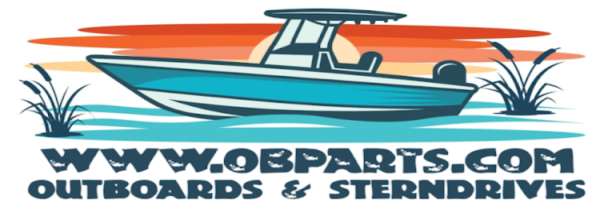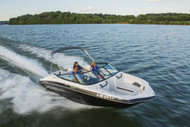What's the difference between a JET OUTBOARD and a JETBOAT?
Jetboats employ a completely different type of propulsion system. Basically, the boat itself isn’t any different than any other, but how it gets around the water is a big departure from a standard motor.
Jet boats range in size from small personal watercraft all the way up to much larger boats. Here are some of the advantages and disadvantages of jet boats.

Advantages
Security: Jet boats are touted as being far safer than a prop-driven boat since there is no rotation prop exposed externally, without any bulky hardware to potentially strike or injure a swimmer or skier. Truth be told, boating is a very safe activity no matter which type of powerplant you have, but knowing that there is no propeller beneath the waterline certainly does give people -- parents specifically -- an added feeling of security.
Draft: Boats with jet drives have always touted their exceptional draft edge from 12 inches up to 17 inches. Unlike a stern drive, a jet typical draft is only the depth of the hull itself. That allows them to go in shallower waters with ease, and eliminates a lot of the worry of running aground or undergoing drive-damage in lanky waters.
Acceleration: Jet boats are also generally quick to plane with very little bow-rise, usually less than 20 degrees. That provides them a superior visibility benefit, as the captain rarely loses sight of what is ahead as the boat comes on airplane. On some propeller-driven ships, a motorist can lose a level of forward vision for as much as three to four seconds. That acceleration is also thrilling, and jets normally have an instantaneous throttle-response that other propulsion systems just can't match.
Handling: And there's a jet boats unbeatable, sportscar-like handling experience. Grown-up or not, jet boats have a ride which appeals to our inner teenager. Together with the thrust capable to be redirected in a flash, jets are quick and nimble. Give the wheel a fast jerk, punch the throttle, and your average jet will leave other ships in its aftermath. Most jets also don't generally charge as severely, enhancing the driver's feeling of control. It's difficult to express just how amazing jet boat handling can be, but you are going to get a taste of this action if you see our video of the Scarab 165 ID, which we place into some seriously crazy turns.
All of that said, jet boats aren't an ideal selection for all individuals, by any way. Like all types of boats they still have their disadvantages as well. A few of those negative traits may be attributed to experience, since boaters with a backdrop utilizing outboards, inboards, or stern drives will always seem to struggle somewhat when clinging to a jet. Still, you'll observe seasoned jet boat drivers that will deal with their boats with utter precision. Like anything, it takes practice. Less is more!

Disadvantages
Shifting into Reverse and Neutral
Jet boats can't reverse the direction of their impeller (For those of you that don't understand this: "This means that a propeller can reverse it's gears to move right or left in direction to give you the propulsion to move forward or in reverse.") This first sentence does not mean that the article states that jet boats can't go in reverse). The Reverse system is accomplished by dropping a reverse gate or bucket over the stream of water exiting the pump nozzle. These reverse gate buckets basically divert that flowing water, therefore it shoots forward rather than aft pushing the water forward to be able to go in reverse. The reverse gate bucket may be positioned to partially divert the atmosphere, mimicking the true neutral. However, the Scarab jet boats come with an INR module that can be adjusted with a positive number or negative number to offset any conditions with a current pressing the bow or stern. We can literally get out of the boat next to a dock in neutral without any movement.
Low-speed handling
Certain brand Jet Boats such as Yamaha tend to suffer in low-speed maneuvering around the dock since they have smaller steering nozzles and reverse gates. Driving in a straight line can be difficult for Yamaha jet boats, with the boat drifting off to one side or the other, especially when it's windy, but can be helped for improvement by adding a rudder setup. Inexperienced drivers often get fooled into over-steering as they proceed through slow pace zones or approach the pier. The difference is not huge, but it will mean that the driver may need to create more regular course-corrections. Adding a touch of throttle will straighten the steering aspect if you are they type of person that wants to drive it like a truck by over-steering. The Scarab jet boats drive like a car with an immediate response requiring less input from the Captain.
Todays jet boats are all relatively high in horsepower and less in cost over a comparable horse powered outboard. Volume Degree: In no small part because they often rev much higher than propeller-driven boats, 2-stroke jet boats commonly are somewhat louder. Boat makers have mitigated this problem somewhat in newer models, and also have been taking pains to reduce noise levels. But jet boats still remain louder and often high in pitch in the 90's, but not in todays models with the newer 4-stroke models.
Posted by


